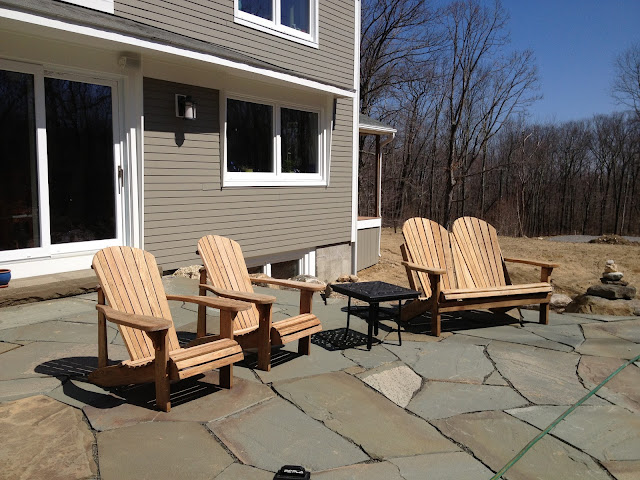In building our home we took a bit of a leap of faith that this stuff actually works. So, the question is does a Passive House really use only a small fraction of the energy of a
code built home to heat? Well, we have some results from January and February
to share.
 |
| On the left behind the garage, a solar hot water collector and 2 air source heat pumps. On the roof, solar PV panels. |
The house is heated by 2 Mitsubishi SEZKD09NA4 ducted air handlers and 2 Mitsubishi SUZKA09NA outdoor heat pump units (see the 2 tiny rectangles to the right of the large solar hot water collector in the photo above). These are small units that ordinarily heat a room or two in a typical house. The heating load for the building only requires one of these units, but the ducting runs would have been too long for a single unit to handle. With the thermostat set to 68 F the whole time, they did an admirable job keeping us warm. Indoor temperatures on the main two floors where these units service ranged from 67 F to 74 F depending on how sunny it was. The basement which isn't heated was cooler.
I bought an eMonitor electricity monitoring system that provides circuit by circuit electricity usage information. The electricity charges for these Mitsubishi units at the current CL&P rate of $0.14/kWh were $66 in January and $58 in February. Compare this to the $300/month in kerosene it costs to heat our smaller empty condo to 53 F so that the pipes won't freeze.
So how does electricity usage in January and February compare to projected usage? It seems a little on the high side, but it's hard to tell. We used 469 kWh in January and 412 kWh in February. The PHPP
(Passive House Planning Package) determined that the heating demand for January and February was 877 kWh and 555 kWh. Our usage was substantially below the demand, but that is because heat pumps extract heat from the outdoor air and produce more indoor heat in kWh than they consume in electricity. The COP (coefficient of performance) of these units is 2.4 at 17 F and 3.1 at 47 F. A COP of 2.4 means that the heat pump will produce 2.4 units of heat for each unit of electricity consumed. The average low temperature for the month in both Jan and Feb was about 17 F. I'd expect a COP of at least 2.4 for Jan and Feb. If the PHPP was correct in computing our heating demand, our effective COP was about 1.9 for Jan and 1.4 for Feb. Both months seemed very cloudy, so it's also possible that the amount of sunshine captured did not match what PHPP assumed causing a higher demand for heat and the Mitsubishis to run more than expected.
One thing I found interesting that you can see in the graph below is the wide variation in electricity consumed by the heat pumps. The range is from 2kWh to 25kWh per day. The amount of sun coming into the house really makes a difference in the amount of heat the heat pumps need to produce. There was a very sunny stretch for 4 or 5 days around Valentine's Day where the average consumption by the heat pumps was 4 kWh per day. I can tell that this was a sunny stretch because the solar hot water tank got up to its limit of 160 F for several days in a row here and electricity usage for hot water was pretty close to zero. Hopefully, we'll see the electricity usage on these Mitsubishi's go to zero soon with warmer temperatures, more daylight hours and fewer clouds.
The Zehnder HRV used more electricity than expected in Jan and Feb,
with costs of $20 and $17 respectively. It turns out that there is a
resistance coil to keep the unit from freezing when outdoor temperatures
get very low that draws electricity relatively frequently. When
temperatures are above freezing the HRV should cost $7/month to run.
On the hot water front, I'm very pleased with the performance of the DIY system I built from the design on Gary Reysa's
www.builditsolar.com website. Running the supplemental/backup on-demand Stiebel Eltron Tempra 24 Plus heater cost $10 in January and $7 in February. I estimate that our family of 4 uses about 75 gallons a day of hot water. I expect electricity usage here to also approach zero soon as we transition into spring and summer.
In January we used $76 worth of electricity for heat and hot water and in February we used $65 worth. The great thing about using this little electricity for these two major energy categories is that it means that the solar electric panels we have on the roof should be able to provide all the electricity that we use in the house over the course of a year.


 On October 5th OCPH will be participating in the NESEA Green Buildings Open House tour organized by the Northeast Sustainable Energy Association. This is the 14th year of the event and there are 373 participant sights throughout the northeast. We are proud to join the tour and share what we have learned and lived.
On October 5th OCPH will be participating in the NESEA Green Buildings Open House tour organized by the Northeast Sustainable Energy Association. This is the 14th year of the event and there are 373 participant sights throughout the northeast. We are proud to join the tour and share what we have learned and lived.

.JPG)

.png)
.png)


















